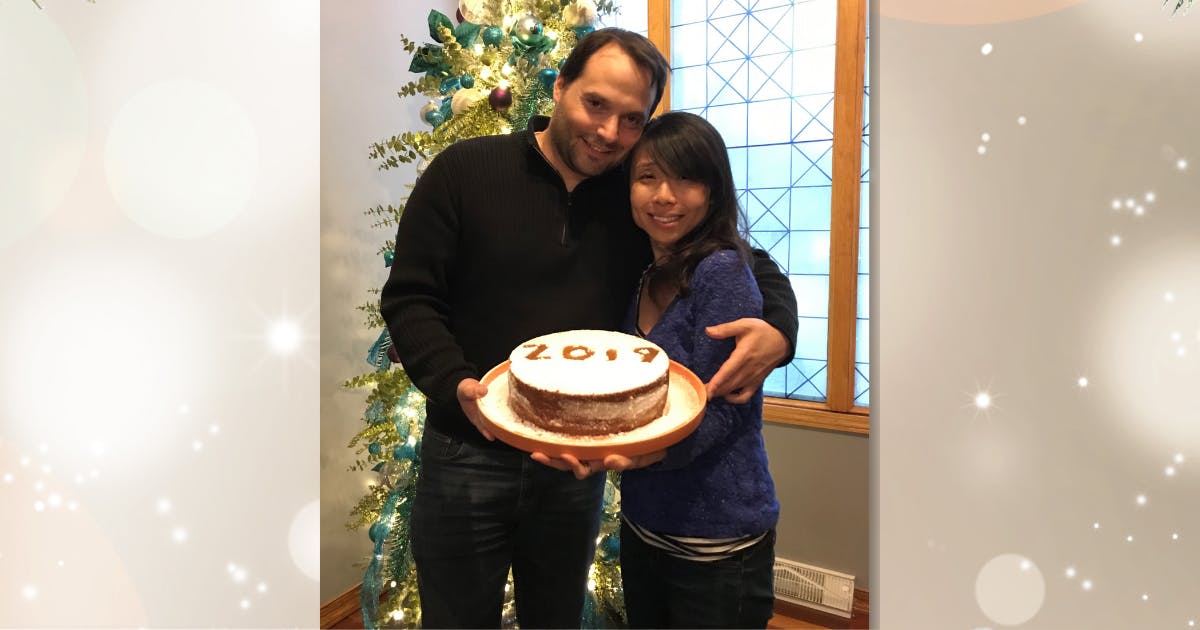
Contributed by: Sam Dorios
Vasilopita is a Greek cake for New Year’s Day. Simple, yet delicious, it is the center of attention as it carries with it a fun holiday tradition: the cake has a hidden coin inside, and whichever family member is blessed with the coin-containing slice is granted good luck for the entire year! Kids love it, and even if they don’t get the coin, they’re still happy to have delicious cake.
Some families cut the cake shortly after midnight, others (such as mine) have it on the morning of January 1. The host of the house cuts the cake: the first piece is for Christ, the second piece is for the house, and then each subsequent piece is for a family member, from oldest to youngest. Family members who are not present are still included; they might not get to eat, but they still enjoy the game by hearing who got the coin.
According to tradition, in the Eastern Roman Empire, citizens were forced to surrender their valuables, such as jewelry, for a surprise tax (or to stop a siege; the story varies). By chance, this was called off and the valuables were to be returned. Saint Basil was tasked with returning them, but nobody knew what belonged to whom. So, he baked everything into loaves of bread and gave them out randomly—and by way of a miracle, every person received back exactly what they surrendered.
Vasilopita
Time
- Preparation: 10-12 minutes
- Baking: 1 hour
Ingredients
Serves 8
Dry Mix
- 3 cups all-purpose flour, sifted
- 2 tablespoons baking powder
- Pinch of salt
Wet Mix
- 2 cups sugar
- 1 cup unsalted butter (2 sticks), softened
- 2 tablespoons of cognac (preferably Metaxa)
- 1 teaspoon vanilla
- Juice from one orange
- Zest from one orange
- 4 eggs, room temperature
- 1 cup milk, room temperature
Extras
- 1 coin, wrapped in aluminum foil
- Powdered sugar (decoration)
Directions
- Preheat oven to 350 °F. Line a large baking sheet with parchment paper; set aside.
- Line the base of a 9-10 inch round pan with wax paper and grease the sides.
- Create the dry mix: in a bowl mix the sifted flour, baking powder, and salt. Set aside.
- Create the wet mix: in a bowl, cream the sugar and butter. Best if butter is soft (but not melted). Add the sugar gradually and beat until fluffy (about 5 minutes).
- Whip the eggs in a small bowl, then gradually add to the wet mix. Mix for 2 minutes.
- Add cognac, vanilla, orange juice, and orange zest to wet mix. Mix (for about 2 minutes).
- Add the dry mix to the wet ingredients, but in four parts. Add one quarter of the dry mix. Mix well (do not overmix). Then add milk. Mix again. Repeat until all mix and milk has been added.
- Wrap coin in a thin layer of aluminum foil. Add coin to the batter.
- Pour batter (it will be thick) in the pan, smoothing the top with a spatula.
- Bake in oven (preheated at 350 degrees F) for about 45-60 minutes. To check if done, poke the center with a thin sharp knife or wooden stick; it should come out clean.
- Remove from oven and let cool.
- Remove cake from pan. Sprinkle with powdered sugar.
NOTE: Some people like to put the coin in after the cake is finished. To do this, when releasing the cake from the pan (step 12), turn cake upside-down on another plate. Wrap the coin in foil and push it through the cake’s bottom. Flip cake back right-side-up. Then decorate with powdered sugar.
Omidyar Fellow Tony Au shares the recipe that always satisfies his inner cookie monster.
